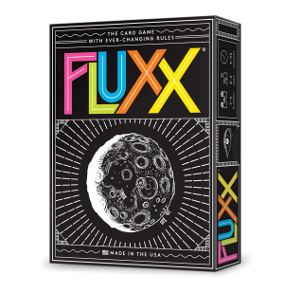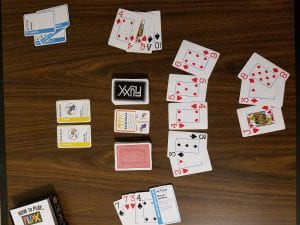Overview:
“Straight Fluxx” is an appropriated game that uses material from the classic poker game “Texas Hold ’em” and the card game “Fluxx”. The objective of the game is to be the first player to create a “straight hand combination” on the table using the “community cards”.
Materials:
- 1 deck of 52 playing cards
- 1 deck of Fluxx

Gameplay:
This game can be played with 2 to 6 players. In order to start the game, both the playing card deck and the Fluxx deck have to be shuffled. Inside the Fluxx deck is a “Basic Rules” card which must be placed on the table at all times. Once the decks are shuffled, both decks are placed on the sides of the “Basic Rules” card on the table. Each player is then dealt 3 cards from the playing card deck and 2 playing cards or “community cards” are placed face up on the table.
When the game begins, as stated on the Fluxx “Basic Rules” card, a player draws one card from either deck and plays one card from their hand. This is subject to change as there are “new rule” cards in the Fluxx deck which changes how the game plays. For example, one “new rule” card says “Play 2” cards per turn. This adds a lot more variety to the game and can either speed things up or slow them down.
In order to win, a player must create a “straight hand combination” using the “community cards” on the table. A “straight” means there are 5 cards in numerical order. So, having a 2, 3, 4, 5, 6 set on the table would make a “straight”. When the game begins, there are only two “community cards” on the table. Players can play poker cards from their hand to add to the “community” pile or play Fluxx cards which will change the current rules or have some other effect on the game.
Rules:
- There is a hand limit of 3 (unless a new rule changes this)
- There is a limit of 5 “community cards” on the table
- If a person plays a playing card, they add the card to the middle. The person can choose to replace a card that is face up. If a person plays a Fluxx “Action” card, the card is discarded when the effect is over. If a person plays a Fluxx “New Rule” card, the card stays in play until another card in the same category is played.
- You can only draw from one deck (i.e. if a “draw two” is in play, you can’t take one from each deck)
Documentation:

This is the paper prototype of “Straight Fluxx”. Here, I use paper cut-outs for the playing cards.

This is the final iteration of “Straight Fluxx”. Here is a completed game.
Iteration / Inspiration:
With my first iteration for this project, I had a completely different idea. My first idea, “Lucky Chess”, used playing cards and chess. The goal of that game was to beat the other team using “Rock, Paper, Scissors” as the battle mechanic. Instead of using actual chess pieces, the playing cards were given different values to represent them. So, if some randomly drew a K from the deck, they would be the King from chess. I was really inspired by Yoko Ono’s “White Chess”. With Yoko Ono’s “White Chess”, she kept the mechanics the same but made all of the pieces white. By doing so, it made it harder to keep track of who owned which pieces. On a deeper level, her game connected with humanity in general. It made no sense for pieces on the board to go against each other since they were all the same. As humans, the conflicts we have among ourselves make no sense because we too are all the same. “Lucky Chess” was meant to be a commentary on the class structure in our society. Those with more wealth and power have special privileges that those with less do not. Also, no one gets to pick the class they belong to when they are born. I wanted to imitate this with the random drawing of the playing cards. Whatever card you had, you were stuck with it. Also, players with higher value cards like the queen were inherently stronger than lower value cards such as the pawn.
From the first play-test, it was clear that the game was a bit too complicated and could better appropriate chess if actual chess pieces were used. Therefore, I decided to scrap the idea and eventually came up with “Straight Fluxx”. It is much simpler than “Lucky Chess”, it does not need a large group of people to play it, and it directly appropriates both decks. I believe it was a better product since I did not focus so much on the message but on the gameplay.
